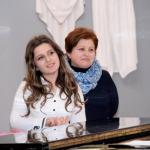Music: Further Education
Primary tabs
Author:
Music can’t give a definite apprehension of objects, phenomena in the way speech does. Like other forms of art it is more sensitive and communicates with emotions. Using emotional peculiarities of art learners get an opportunity to enhance their own experience in cognitive functioning, logical thinking and develop the framework of self-education, creativity and cooperativeness.
Music, as a component of public education, is particularly highlighted. Music teachers are given an opportunity to make path to their self-discovery and self-realization not only by means of lesson hours allocated in the curriculum, but also with all the events mentioned in the educational calendar, with general morning trainings, media Fridays, with musical festivals “Anti-Virus Komitas”, “Komitas Days”, “Resonance”.
Musical further education has been consistently carried out by the “Musical Centre” of the “mkhitar Sebastatsi” Educomplex. At the beginning of our activities we had two options. The first one was to go along the beaten and well-known path, and the second one was to create a new path, a new author educational program relying on our professional and pedagogical experience. The aims, key objectives and programs were changed. Learners with their preferences were pushed to the foreground.
We made the first step by changing the accepted forms of concerts in the sense of their contents and structure. Our concerts ceased to be merely undertakings the aim of which was only to show others how much the learners have learned to play a musical instrument. The concerts became performances with their dynamic development, culmination point and cadence chord. During performances we began showing electronic materials made by the learners. Such concerts attracted new learners, and new sections started: guitar, violin. Each concert became a project devoted to a composer, a genre of music or a theme. The music teachers and parents also took part in the concerts. This was also a sort of overcoming already established stereotypes. It is an accepted norm that only learners make their performances at musical school concerts. At our Musical Centre the teachers also perform at concerts and from the one hand it is a good example for the learners to follow, and from the other hand we enjoy good music.
We begin each school year with the project “Komitas” which includes 7 dances and 12 piano plays which are not even performed by the students of Komitas State Conservatoire. If Komitas is the warrant of our national way of thinking and self-expression, Bach's music has no boundaries: it is worldwide or universal. So our righteous way or true path to self-discovery and self-realization is through assimilation of the heritages of both Komitas and Bach. Bach's concerts, vocal and instrumental pieces are performed with our own reproductions for the guitar, violin and piano.
Let's consider more popular genres. Why can’t we teach jazz, blouse? All the genres of music have their deep national roots, don’t they? Before performing melodies from films, animated cartoons we usually watch these films, listen to their melodies and then discuss them in the classroom and in the families. By watching these classical films and listening to their melodies they somehow intercommunicate with the works created by Charles Chaplin, Fellini, Nino Rota, Gershwin. In this way families cease to be passive spectators and become active participants. Mothers, fathers, grandparents, aunts and uncles have taken part in the projects of family ensembles. This means long lasting joint work both in the classroom and in the families when musical education unites family and school.
We carry out musical projects dedicated to different countries. Besides performing the music of a certain country we also try to study its geography, traditions and some expressions in the language they speak in this country. Such projects are not only educational and cognitive but also they give the learners positive emotions of self-expression and self-realization.
I want to single out the work which is carried out with the computer musical program Sibelius. Not only can the text of musical notes be typed with this program but the typed notes can be sounded as well. During one of our concerts an extract from Mozart's opera The Magic Flute was reproduced for the piano and orchestra with this program.
It seemed we didn't have anything new to say but there came the opera. The opera is a multi-genre piece of art, and so the work on it is diverse and exciting. It comprises in itself directing, stagecraft, stage decorations, costume designing, dancing divertissements, vocal solos and choir performances. Our choice of the opera The End of Evil wasn’t at random. All the learners of the Musical Center took part on Saturday rehearsals. Many of them came with their parents. Some parents offered their assistance. Cooperation of the learners and parents of different age groups and generations took place here.
Our next concert took place on Rodari Days according to our educational calendar. It was the piano performance of the Ballet Pinokio by K.Khachatryan. The concert was accomponied by Lilit Grigoryan's animated films.
Our Musical Center also gives much significance to the creation and taking care of indoor and outdoor plants which are inseparable part of our environment. Plants as well as children need to be taken care of every day. This work is done with pleasure.
Musical further education in our Center is our author educational program which doesn't exclude children studying with inclusive educational program.

